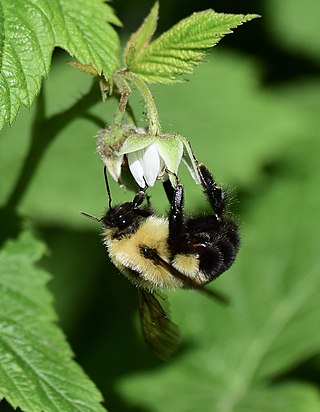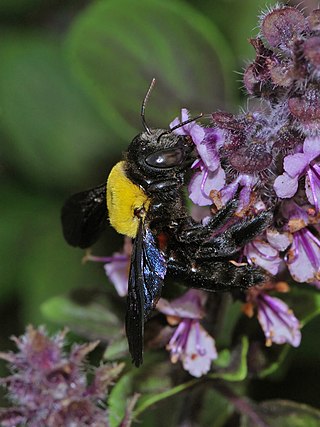
Osmia lignaria, commonly known as the orchard mason bee or blue orchard bee, is a megachilid bee that makes nests in reeds and natural holes, creating individual cells for its brood that are separated by mud dividers. Unlike carpenter bees, it cannot drill holes in wood. O. lignaria is a common species used for early spring fruit bloom in Canada and the United States, though a number of other Osmia species are cultured for use in pollination.

Hylaeus is a large and diverse cosmopolitan genus within the bee family Colletidae. This genus is also known as the yellow-faced bees or masked bees. This genus is the only truly globally distributed colletid, occurring on all continents except Antarctica.

Habropoda laboriosa, the southeastern blueberry bee, is a bee in the family Apidae. It is native to the eastern United States. It is regarded as the most efficient pollinator of southern rabbiteye blueberries, because the flowers require buzz pollination, and H. laboriosa is one of the few bees that exhibit this behavior. It is active for only a few weeks of the year, while the blueberries are in flower during early spring, when the temperature is warm and humid. H. laboriosa are solitary bees that live alone but nest in close proximity with other nests of their species. They have similar features to bumble bees, but they are smaller in size compared to them. H. laboriosa are arthropods so they have segmented bodies that are composed of the head, thorax, and abdomen.

The two-spotted bumble bee is a species of social bumble bee found in the eastern half of the United States and the adjacent south-eastern part of Canada. In older literature this bee is often referred to as Bremus bimaculatus, Bremus being a synonym for Bombus. The bee's common name comes from the two yellow spots on its abdomen. Unlike many of the other species of bee in the genus Bombus,B. bimaculatus is not on the decline, but instead is very stable. They are abundant pollinators that forage at a variety of plants.

Bombus vosnesenskii, the yellow-faced bumblebee, is a species of bumblebee native to the west coast of North America, where it is distributed from British Columbia to Baja California. It is the most abundant species of bee in this range, and can be found in both urban and agricultural areas. Additionally, B. vosnesenskii is utilized as an important pollinator in commercial agriculture, especially for greenhouse tomatoes. Though the species is not currently experiencing population decline, urbanization has affected its nesting densities, and early emergence of the B. vosnesenskii has been implicated in the increasing lack of bee diversity on the West coast.

Bombus occidentalis, the western bumblebee, is one of around 30 bumblebee species present in the western United States and western Canada. A recent review of all of its close relatives worldwide appears to have confirmed its status as a separate species.

Anthidium manicatum, commonly called the European wool carder bee is a species of bee in the family Megachilidae, the leaf-cutter bees or mason bees.
Hylaeus longiceps, also known as the longhead yellow-faced bee, is a species of bee endemic to Hawaii and known from only six populations. In September 2016, along with six other Hawaiian yellow-faced bee species, H. longiceps was listed for protection under the United States Endangered Species Act. This marked a first listing for any bees species in the US.

Bombus affinis, commonly known as the rusty patched bumble bee, is a species of bumblebee endemic to North America. Its historical range in North America has been throughout the east and upper Midwest of the United States, north to Ontario, Canada, where it is considered a "species at risk", east to Quebec, south to Georgia, and west to the Dakotas. Its numbers have declined in 87% of its historical habitat range. On January 10, 2017, the United States Fish and Wildlife Service placed B. affinis on the list of endangered species, making the rusty patched bumblebee the first bee to be added to the list in the continental United States.

Bombus terricola, the yellow-banded bumblebee, is a species of bee in the genus Bombus. It is native to southern Canada and the east and midwest of the United States. It possesses complex behavioral traits, such as the ability to adapt to a queenless nest, choose which flower to visit, and regulate its temperature to fly during cold weather. It was at one time a common species, but has declined in numbers since the late 1990s, likely due to urban development and parasite infection. It is a good pollinator of wild flowers and crops such as alfalfa, potatoes, raspberries, and cranberries.

The Oriental carpenter bee, Xylocopa nasalis, or Xylocopa (Biluna) nasalis, is a species of carpenter bee. It is widely distributed in Southeast Asian countries. It is a major pollinator within its ecosystem, and is often mistaken for a bumblebee. The species leads a solitary lifestyle with a highly female-biased colony in the nest.

Xylocopa pubescens is a species of large carpenter bee. Females form nests by excavation with their mandibles, often in dead or soft wood. X. pubescens is commonly found in areas extending from India to Northeast and West Africa. It must reside in these warm climates because it requires a minimum ambient temperature of 18 degrees Celsius in order to forage.
Hylaeus anthracinus is a species of bee, also known by the common name anthricinan yellow-faced bee. It is endemic to Hawaii and known from only 16 populations. In September 2016, along with six other Hawaiian Hylaeus species, H. anthracinus was listed for protection under the United States Endangered Species Act. This marked a first listing for any bee species in the US.
Hylaeus assimulans is a species of bee, also known by the common name Assimulans yellow-faced bee. It is endemic to Hawaii and known from only five populations. In September 2016, along with six other Hawaiian Hylaeus species, H. assimulans was listed for protection under the United States Endangered Species Act. This marked a first listing for any bee species in the US.
Hylaeus facilis is a species of bee, also known by the common name easy yellow-faced bee. It is endemic to Hawaii and known from only two populations. In September 2016, along with six other Hawaiian Hylaeus species, H. facilis was listed for protection under the United States Endangered Species Act. This marked a first listing for any bee species in the US.
Hylaeus hilaris is a species of bee, also known by the common name hilaris yellow-faced bee. It is endemic to Hawaii and known only from a single population. In September 2016, along with six other Hawaiian Hylaeus species, H. hilaris was listed for protection under the United States Endangered Species Act. This marked a first listing for any bee species in the US.
Hylaeus kuakea is a species of bee that is endemic to Hawaii and known from only two populations. In September 2016, H. kuakea and six other Hawaiian yellow-faced bee species were listed for protection under the United States Endangered Species Act. This marked a first listing for any bee species in the US.
Hylaeus mana is a species of bee that is endemic to Hawaii and known from only four populations. In September 2016, along with six other Hawaiian yellow-faced bee species, H. mana was listed for protection under the United States Endangered Species Act. This marked a first listing for any bee species in the US.

Augochloropsis is a genus of brilliant metallic, often blue-green, sweat bees in the family Halictidae. There are at least 140 described species in Augochloropsis.

Hylaeus relegatus is a bee species in the family Colletidae. It is endemic to New Zealand and was first described by Frederick Smith. It is the largest and most common species of this genus in that country. H. relegatus can be found throughout the three main islands of New Zealand and visits the flowers of a wide variety of plant species, both native and introduced. Although widespread, this species is not abundant at any one particular location. It has been hypothesised that human made nest sites can be used to increase its numbers.












